Minolta Rangefinder Lenses
A Description of Minolta Rangefinder Cameras Lenses produced 1947-1959
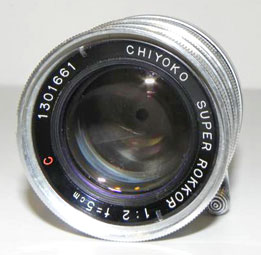
the Super Rokkor 5cm f2.0 of 1955
Minolta Rangefinder Lenses and the Minolta-35
Some Minolta History
Minolta was started in Osaka 1928 by Kazuo Tashima who was born in 20 November 1899 and who remained the central figure in Minolta until 1982. Minolta's original name was 日独写真機商店 - Nichidoku Shashinki Shōten or "Japanese-German Camera Workshop", and his initial cameras in fact used lenses imported from Germany. His first cameras used the Nifca brand name, and his first camera, the Nifcarette (a folding camera taking Kodak 127 film) was launched in 1929. In 1931, Tashima renamed the company Molta, and for the first time, the Minolta brand was used on cameras. Six years later in 1937, this Osaka company was renamed 千代田光学精工㈱ "Chiyoda Kogaku Seiko Kabushiki Kaisha" or "Chiyoda Optics and Precision Industry Co., Ltd". This is sometimes simply referred to as "Chiyoko" - 千代光 - in some logos and publications. 13
After 1937, the Minolta name continued to be used as a camera brand. "Chiyoda-Kogaku" as a company name was often engraved on Minolta cameras, until in 1962, the company changed its name to Minolta Camera Co., Ltd. (ミノルタカメラ㈱)
The Minolta-35, Chiyoda Kogaku's first 35mm camera was introduced in 1947 with the 45mm f2.8 Super Rokkor in a M39 lens mount.
This 45mm f2.8 lens was standard on the Minolta-35 for the next 8 years. It was marketed with Minolta's "Rokkor" lens name as well as "Chiyoko", a phonetic contraction of Chiyoda Kogaku". "Rokkor" refers to the Rokkor or Rokko mountains near the Osaka (Mukogawa factory) manufacturing location.
The 45mm focal length for a standard 35mm rangefinder lens was unusual and nearly every other camera of the 1940s, 1950s and into the 1960s offered a 50mm lens as standard. Reference books give the technical definition of a standard lens as one whose focal length roughly matches the diagonal of the film or the image sensor. For a standard full-frame 35mm camera this gives a focal length of approximately 43mm. 8
Unlike Canon, the leading Japanese rangefinder manufacturer at the 1947 launch of the Minolta-35, the lens mount adopted by Chiyoda Kogaku was was an exact copy of the Leica M39 - a 39mm diameter mount, with a thread pitch of 26 threads per inch. 5, 15
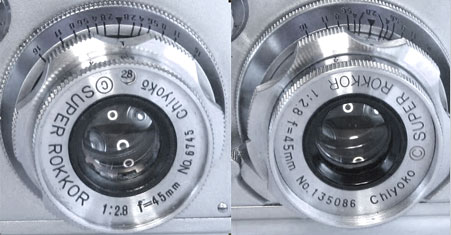
Super Rokkor 45mm f2.8
left: 1948 lens with a circular opening for the f-stop and "Chiyoko" labeling
right: 1953 Rokkor 45mm f2.8 with more compact focusing and revised depth-of-field markings
The Super Rokkor 45mm f2.8 lens was of 5 elements in 3 groups. The manufacture from 1947 to was in six versions:
- 45mm f2.8 first series (1947-1948): serial numbers 20xx, 30xx, 40xx.
- 45mm f2.8 second series (1948-1949): serial numbers 30xx to 150xx.
- 45mm f2.8 third series (1949-1951): serial numbers 150xx, 160xx, 170xx. First 45mm f2.8 to have a focusing lever.
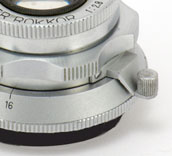
- 45mm f2.8 fourth series (1951-1952): serial numbers 15xx to 200xx. First 45mm f2.8 without the circular opening showing the f-stop.
- 45mm f2.8 fifth series (1952-1953): serial numbers 135xxx.
- 45mm f2.8 sixth series (1953-1955): serial numbers 140xxxx. No provision for the small 19mm filter in the inner lens ring, such as in previous 45mm f2.8 lenses.
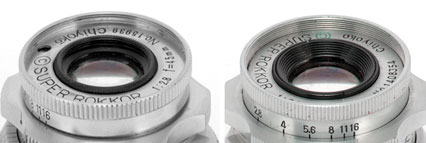
(l) Super 45mm f2.8 with provision for a small 19mm filter (r) new inner ring without filter threads
Minolta-35 Lens Selection
The Rokkor lens selection for the Minolta-35 was somewhat limited when compared with other leading 35mm rangefinder lens ranges of the period. For example, as far as is known from present research, no lens wider that 35mm was ever offered. Also, fast lens formulations of f2.0 were not generally offered 1947 to 1955. Faster normal lenses were introduced in July 1955: the Super Rokkor 5cm f2.0 and the 5cm f2.8. 5
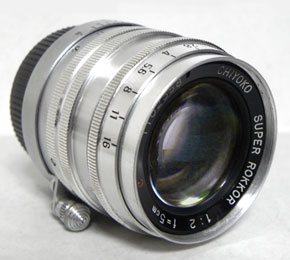
a Super Rokkor 5cm f2.0 with f16 minimum aperture and 40.5 mm filter size
Super Rokkor 5cm f2.0
This multi-coated f2.0 lens has become popular in the Japanese after-market because of its image quality and solid build. Two Japanese commentators remarked favorably as to the 5cm f2.0 "expressive bokeh".
The lens design is of 7 elements in 6 groups. This lens was also manufactured in two slightly different structures, each having a different front ring and with different front filter diameters:
- 5cm f2.0 first type: serial numbers 110xxxx. filter diameter is 40.5 mm - same as filter size for most 45mm f2.8 lenses.
- 5cm f/2.0 later types: serial numbers 120xxxx, 130xxxx, 140xxxx, 150xxxx. filter diameter is 43 mm. Some of the later types had the red "C" on the front identification, and some lacked the "C". Also, some of these later types had minimum apertures of f16 and others of f22. However, all had the 43mm filter diameter. 13
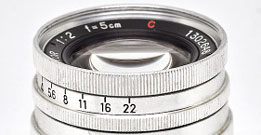
the Super Rokkor 5cm f2.0 with f22 minimum aperture and 43mm filter size
Super Rokkor 5cm f2.8
This Super Rokkor 5cm f2.8 lens is also multi-coated, and was introduced in 1954 14 when the Minolta-35 Model II was in production.
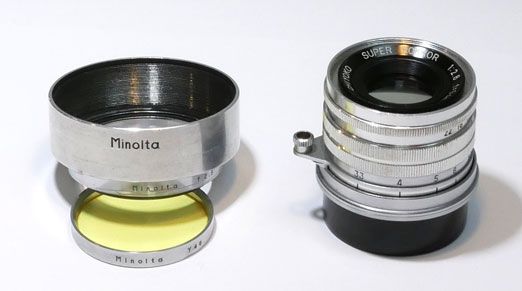
Super Rokkor 5cm f2.8 with its hood and Minolta filter
The Super Rokkor 5cm f2.8 of 1954 is a lens of 5 elements in 3 groups. It has a filter diameter of 40.5 mm and a minimum aperture of f22. 13 Solidly built, it had a weight of 175 grams compared with the 130 gram weight of the contemporaneous Canon 50mm f2.8. 2
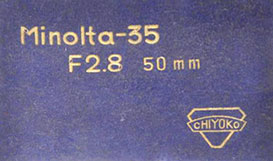
The Super Rokkor 5cm f2.8 was produced in two series:
- 5cm f2.8 first type (1954): serial numbers 150xxxx. filter diameter 40.5 mm.
- 5cm f2.8 first type (1955): serial numbers 160xxxx. filter diameter 40.5 mm.
About 1,600 of these Rokkor 5cm f2.8 lenses were manufactured during these two years 14
Super Rokkor 5cm f1.8
With the introduction of the Minolta-35 Model IIB in May 1958, Minolta presented a new look in its lens design. This was the Super Rokkor 5cm f1.8, with a wide black focusing ring and black f-stop ring contrasting with a satin finish chromium body. This gave the lens a modern look to go with the totally new Minolta-35 Model IIB. This also was the look which was to be embodied in the successful Minolta SR series lenses for its single-lens reflex introduction.
This 5cm lens is of 6 elements in 5 groups. The manufacture in 1958 and 1959 was in two series:
- 5cm f1.8 first series: serial numbers 120xxxx. Approximately 7,500 units were manufactured.
- 5cm f1.8 second series: serial numbers 130xxxx. Approximately 3,000 units were manufactured.
- filter diameter for both series was 46mm.14
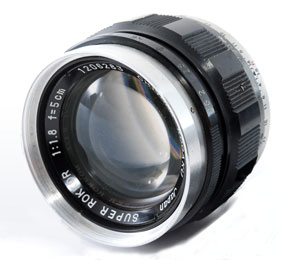
a Super Rokkor 5cm f1.8 from the first production series.
This lens, like the previous Rokkor 5cm f2.0 has a very good reputation among photographers today still using this type of lens - sometimes even on digital bodies. However, because of its relatively small production run, the price on used markets has been bid up by collectors, which has tended to preclude those who would buy to use.
Minolta Lens Innovation: The Rokkor 3.5cm f3.5
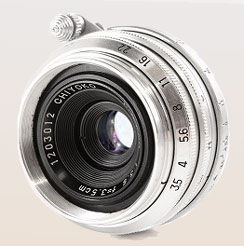
multi-coated Minolta Rokkor 35mm f3.5 of 1956
In 1956, Minolta introduced the Rokkor 3.5cm f3.5 wide angle lens. This has been described as the first "multi-layer achromatic coated" Japanese lens. 18 This was process was described technically:
In 1956, Minolta pioneered its "achromatic coating" which was two layers of magnesium fluoride deposited in different thicknesses. Minolta were using the term "achromatic coating" well into the 1970's.
This multi-layer lens coating was also applied to the Rokkor 5cm f1.8 and 5cm f2.8 lenses offered in 1955 and marked with "C".
The Rokkor 3.5cm f3.5 design was of 4 elements in 3 groups. It used a 34mm filter size and had an f22 minimum aperture.
More advanced methods of coating and multi-coating of camera lenses had an effect on lens design. Expert Sidney Ray wrote: "The availability of anti-reflection coating permitted the Double Gauss to rise to dominance over the Sonnar. The Sonnar had more popularity before World War II because, before antireflection coating, the Sonnar's three cell with six air-glass surfaces versus the Double Gauss's four and eight made it less vulnerable to flare." 17
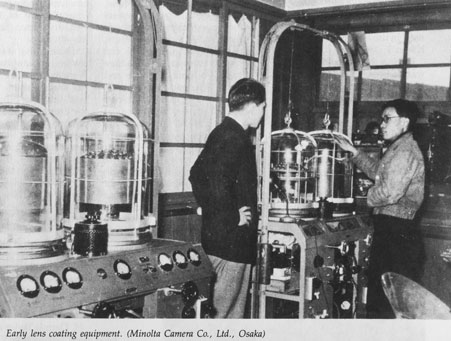
early Minolta lens coating process
Success of the Rokkor 35mm f3.5
This lens did not sell particularly well since a 35mm f3.5 was a slow lens even for 1956. No other wide-angle lenses seem to have been widely commercialized by Chiyoda-Kogaku for the Minolta-35 camera. camera-wiki.org lists a Super Rokkor 3.5cm f1.8 lens of 6 elements in 4 groups, but so far, I have not seen such a lens, nor found information about its construction by Chiyoda-Kogaku.
Minolta Rokkor 35mm f1.8
Steven Pollock, an expert in photography and photographic equipment, reports that a Rokkor 35mm f1.8 lens was introduced at the time of the launch of the "Minolta 35 IIB camera at the 1958 Photokina trade show". 19 This lens was in the same finish as the Super Rokkor 5cm f1.8 introduced in a modern mount also in 1958. Since I have not seen other examples of this 35mm f1.8 lens, other than Steven Pollock's example, I conclude that production was small. However, the lens is listed in the Minolta-35 documentation of Dominique and Jean-Paul Francesch 20, so may have been offered commercially.
Thanks for the photo Steven!

Rokkor 35mm f1.8 introduced in 1958
Minolta Rokkor Long and Telephoto Lenses
85 mm long lens
One of the fine quality M39 Rokkor long lenses introduced by Minola was the Super Rokkor 85mm f2.8. The Chiyoda-Kogaku Rokkor 8.5m is a 5 element in three groups 3-1-1 design (thanks to BrianS for this clarification.) Filter size was 48mm. The smallest f-stop was only f16, perhaps due to the wide f2.8 aperture design.
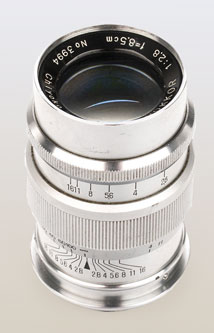
Chiyoda-Kogaku Super Rokkor 8.5m f2.8 medium focal length lens for the Minolta-35
The production in 1948 was of a lens series numbered 3xxx, followed by a second series numbered 5xxx. This second series had a larger base ring. Total units produced was approximately 3,500 lensess over two years of the two series combined. The filter diameter was 40mm.
Tele Rokkor 11cm f5.6 telephoto
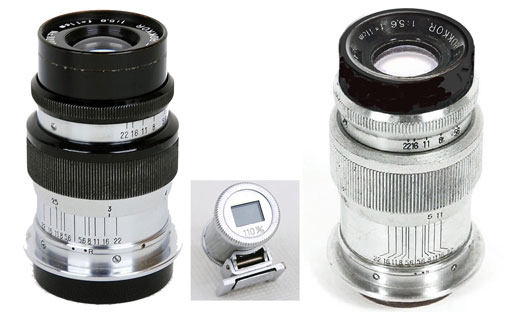
Chiyoda-Kogaku Rokkor 11cm f5.6 telephoto with 110mm finder - black/chrome and satin chrome finish
The Rokkor 11cm f5.6 was an unusual lens in several aspects: no other 35mm camera of that era offered a 110mm interchangeable lens. Also, the maximum f5.6 aperture was slow even for a telephoto lens. The focal length 11 cm (110mm) f5.6 Tele Rokkor was produced in a chrome body with black head ring and black f-stop and focusing rings. It was also manufacuted in an all-chrome body, which seems to have been rarer than the black/chrome version (although both versions are rare in the after-markets).
The telephoto Rokkor 11cm f5.6 is of 4 elements in 2 groups. The minimum aperture was f22 and the filter size was 34mm. The 1948 production used serial numbers of the series 3xxx. A small addition series (probably 1950) had serial number of 23xxx. Approximately 1000 units of the two series were manufactured. 14
The black paint on these Rokkor telephotos was not particularly resistant and rubbed and flaked off in many examples.
Tele Rokkor 135 mm telephoto
The 135mm f4.0 Tele Rokkor was also produced in a satin-chrome finish. This lens from 1949 is shown below.
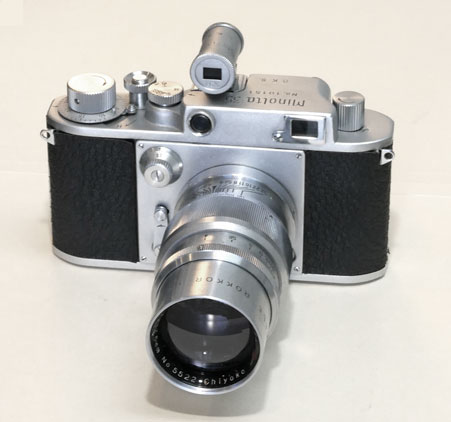
Tele Rokkor 13.5cm f4.0 mounted on a Minolta-35 Model D of 1949
The Rokkor 13.5cm f4.0 was of 4 elements in 3 groups. Filter size was 40mm. The 1948 production was of a series 3xxx and a second series of 5xxx. A third production series with different series numbers: 1200xxx ending in 1958 with production limited to about 1000 units. 14 The Rokkor 13.5cm f4.0 of this final production is shown in the photograph below.
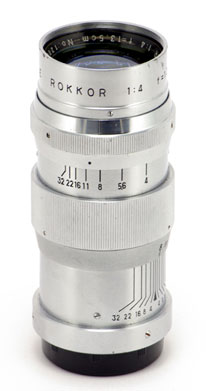
Third series Rokkor 13.5cm f4.0 of 1958
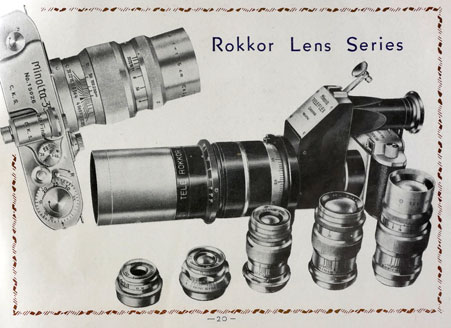
Minolta-35 Rokkor lens range
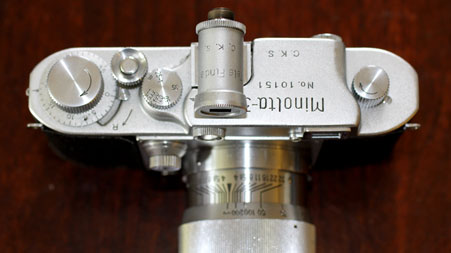
Tele Rokkor 135mm f4.0 with finder on a Minolta-35 Model D of 1951
You can click on the links in the table below to consult other pages of the canonrangfinder.org site.
| Navigation: Click Below to Jump to Desired Subject Page | ||
|---|---|---|
| Canon Rangefinder Cameras - 1 | Canon Rangefinder Cameras - 2 | Canon Rangefinder Lenses |
| Canon Hansa | Canon IIAF, IIAX | Development Nikkor 50mm |
| Canon S | Canon IVSB2 | Canon 19mm |
| Canon J | Canon IIS2, IID2, IIF2 | Canon 25mm |
| Canon NS | Canon VT, Canon L2 | Canon 28mm |
| Canon JS | Canon L1, L3 | Canon 35mm |
| Canon S-I | Canon VT Deluxe | Canon 50mm |
| Canon J-II | Canon VL, VL2 | Canon 85mm |
| Canon S-II | Canon VI-L, VI-T | Canon 100mm |
| Canon IIB | Canon P | Canon 135mm |
| Canon III, IIC, IV | Canon 7 | Canon 200mm-1000mm |
| Canon IIIA, IVF, IVS | Canon 7s | Canon Accessories |
| Canon IIA, IID, IID1 | Nicca Rangefinders | Canon Finders |
| Canon IVSB | Minolta Rangefinders | Minolta Lenses |
| Canon IIF, IIS | Other Rangefinders | other M39 lenses |
| Go to canonrangefinder.com home page | ||
Any additions or corrections to these pages would be welcome simply by contacting this site as shown at the foot of this page .
Footnotes:
1 Dechert, Peter. Canon Rangefinder Cameras 1933-1968. Hove Collectors Books. West Sussex, United Kingdom. 1985. ISBN 0-906447-30-5.
Peter Dechert's book is the most important expert source of information regarding Canon Rangefinder Cameras.
2 Kitchingman, Peter. Canon M39 Rangefinder Lenses 1939-1971. A Collector's Guide. Published by Peter Kitchingman. Perth, Australia. 2008. ISBN 978-0-646-48144-9.
Peter Kitchingman's book is the definitive study of the more than three decades of M39 format camera lenses developed for Canon Rangefinder Cameras.
3 Nostalgic Canon Camera Book. 懐かしいキヤノン EI Publishing Co. Ltd. Tokyo, Japan. June 2003.
Peter Kitchingman's book is the definitive study of the more than three decades of M39 format camera lenses developed for Canon Rangefinder Cameras.
4 "Canon Camera Museum" history website. https://global.canon/en/c-museum/history/ published by Canon, Inc. accessed in 2019.
5 Rajner, Hans P. (author), John Wade (editor). Leica Copies. Classic Collections Publications. London, UK. ISBN 13: 9781874485056
Hans P. Rajner's book is an excellently detailed and carefully researched study of camera from around the world which used the Leica M39 lens mount and the same lens to film plane distance.
7 Dechert, Peter. Canon Single Lens Reflex Cameras 1959-1991. Historical Camera Publications. Yakima, Washington. 1992. ISBN 1-879561-04-2.
8 Tomlinson, Shawn M. The Film Photography Book. Lulu Pulbications. 2016. ISBN: 9781365263972
9 Sartorius., Ghester. Identifying Leica Lenses. Classic Camera 19. Tokyo, Japan. 2001. ISBN 4-257-12029-0
10 website http://www.nicovandijk.net/rflensmatrix.htm consulted 2019.
11 O'Reagan, Douglas M. Allied Exploitation of German Science after World War II. Johns Hopkins University Press. Baltimore, Maryland. 2019. ISBN 9781421428888
12 website www.canonrangefinder.servehttp.com consulted 2008.
13 Minolta expert Andrea Aprà has posted information on minoltarangefinders group and other groups and further detailed information by email. (thanks Andrea !)
14 website http://www.collection-appareils.fr/objectifs/ consulted 2019.
15 Small, Marc James. Non-Leitz Leica Thread-Mount Lenses. Wittig Books. Hückelhoven, Germany. 1997. ISBN 3-930359-47-2.
16 the Nikon Corporation website: https://imaging.nikon.com/history/ consulted 2019.
17 p 152. Ray, Sidney F. Photographic Lens ISBN 9780240510323
18 website http://www.rokkorfiles.com/Lens%20History.html accessed 2019
19 email from Steven Pollock of December 2020
20 Dominique and Jean-Paul Francesch. Histoire de l'Appareil Photographique Minolta Dessain et Toira. Paris. 1985.
21 Asahi Camera.; Tokyo March 1954, February 1955.
If you have any comments or questions about this Canon Rangefinder site, please e-mail me (Larry Huffman) at e-mail address: [email protected]